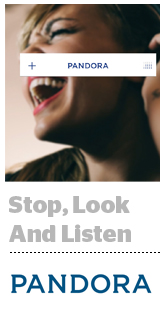 Pandora knows sound. Now the music streaming service is experimenting with sight and motion in its quest for new users – and mobile is the central battleground.
Pandora knows sound. Now the music streaming service is experimenting with sight and motion in its quest for new users – and mobile is the central battleground.
More than three-quarters of Pandora’s roughly 80 million monthly active users listen on mobile.
“We want to acquire and engage high-quality listeners – aka users who actively use the app on a regular basis – and that’s where our KPIs are focused,” said Lisa Sullivan-Cross, Pandora’s VP of growth. “It’s extremely important for the long-term growth of our business.”
Pandora doesn’t judge its success on clicks or app downloads that don’t lead to engagement and overall campaign ROI, which is why mobile video is an appealing medium – a blend of branding and DR.
“Video allows for a richer experience and interaction with existing customers and with potential customers,” said Sullivan-Cross, who runs Pandora’s mobile user acquisition efforts. “It also helps us qualify the conversion before the click. We have more space to communicate our message in a video, which means that users know more about the brand and the product before they even click.”
The potential benefits are clear, which is why Pandora is in the midst of running a month-long test with app marketing platform AppLovin to get a clearer picture of how much money should go toward mobile video as an acquisition channel. The majority of Pandora’s budget has shifted from the web to mobile over the past couple of years, Sullivan-Cross said.
An in-house team at AppLovin helps clients develop the creative. The videos, which end with a call to action to download the app, are then distributed through AppLovin’s network of several thousand publishers. AppLovin continues to track a user’s activity after the video view.
But in Pandora’s case, its widespread brand recognition posed an unusual challenge – that of converting people who are aware of Pandora but haven’t yet downloaded the app for whatever reason.
“I don’t know who in the space hasn’t at least heard of Pandora and that can make it difficult to acquire new users,” said Adam Foroughi, CEO and co-founder of AppLovin. “But when you have a full screen to work with, as you do with video, you can demonstrate the key features and advantages of an app to help the consumer visualize what they’re getting – you can’t really do that with banners.”
Pandora kept targeting simple. The video was only served to people who did not yet have the Pandora app installed on their phone.
“The beautiful thing of it is that everyone loves music,” said Foroughi, noting that users who come in through video generally show more engaged downstream funnel activity than with other channels.
AdExchanger Daily
Get our editors’ roundup delivered to your inbox every weekday.
Daily Roundup
Although it’s still early – the test will continue to run for at least another week – Pandora has seen some promising initial results, with mobile video outperforming banner click rate by roughly 6X and conversion by around 3X.
Sullivan-Cross is pleased with the numbers, but it’s a cautious optimism. When the campaign ends, Pandora plans to take some time to evaluate the impact of video on overall listener quality, retention and engagement – metrics that go deeper than the initial click.
As Heidi Browning, SVP of strategic solutions at Pandora, noted in a previous interview with AdExchanger: “We’re getting away from impression-based advertising and focusing on a true value exchange. We’re about earning the attention of our listeners.”













